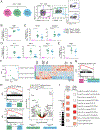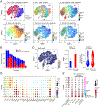Checkpoint Blockade Immunotherapy Induces Dynamic Changes in PD-1-CD8+ Tumor-Infiltrating T Cells
- PMID: 30635236
- PMCID: PMC6336113
- DOI: 10.1016/j.immuni.2018.11.014
Checkpoint Blockade Immunotherapy Induces Dynamic Changes in PD-1-CD8+ Tumor-Infiltrating T Cells
Abstract
An improved understanding of the anti-tumor CD8+ T cell response after checkpoint blockade would enable more informed and effective therapeutic strategies. Here we examined the dynamics of the effector response of CD8+ tumor-infiltrating lymphocytes (TILs) after checkpoint blockade therapy. Bulk and single-cell RNA profiles of CD8+ TILs after combined Tim-3+PD-1 blockade in preclinical models revealed significant changes in the transcriptional profile of PD-1- TILs. These cells could be divided into subsets bearing characterstics of naive-, effector-, and memory-precursor-like cells. Effector- and memory-precursor-like TILs contained tumor-antigen-specific cells, exhibited proliferative and effector capacity, and expanded in response to different checkpoint blockade therapies across different tumor models. The memory-precursor-like subset shared features with CD8+ T cells associated with response to checkpoint blockade in patients and was compromised in the absence of Tcf7. Expression of Tcf7/Tcf1 was requisite for the efficacy of diverse immunotherapies, highlighting the importance of this transcriptional regulator in the development of effective CD8+ T cell responses upon immunotherapy.
Keywords: CD8(+) T cell; PD-1; Tim-3; cancer; checkpoint blockade; dysfunction; exhaustion; immunotherapy; memory; single-cell.
Copyright © 2018 Elsevier Inc. All rights reserved.
Conflict of interest statement
Declaration of interests
A.C.A. is a member of the SAB for Potenza Therapeutics and Tizona Therapeutics, which have interests in cancer immunotherapy. V.K.K. has an ownership interest and is a member of the SAB for Potenza Therapeutics and Tizona Therapeutics. A.C.A.’s and V.K.K.’s interests were reviewed and managed by the Brigham and Women’s Hospital and Partners Healthcare in accordance with their conflict of interest policies. A.R. is a SAB member for Thermo Fisher and Syros Pharmaceuticals and Driver Group. A provisional patent application was filed including work in this manuscript.
Figures







Comment in
-
The First Shall (Be) Last: Understanding Durable T Cell Responses in Immunotherapy.Immunity. 2019 Jan 15;50(1):6-8. doi: 10.1016/j.immuni.2018.12.029. Immunity. 2019. PMID: 30650381
References
-
- Blondel VD, Guillaume J, Lambiotte R, and Lefebvre E (2008). Fast unfolding of communities in large networks. Journal of Statistical Mechanics: Theory and Experiment 2008, P10008.
Publication types
MeSH terms
Substances
Grants and funding
LinkOut - more resources
Full Text Sources
Other Literature Sources
Molecular Biology Databases
Research Materials

